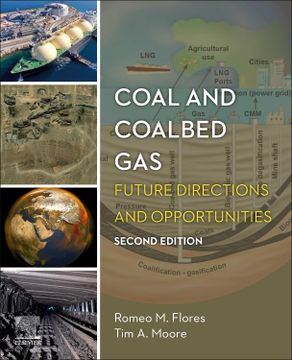Reseña del libro "Coal and Coalbed Gas: Future Directions and Opportunities (en Inglés)"
Coal and Coalbed Gas: Future Directions and Opportunities, Second Edition introduces the latest in coal geology research and the engineering of gas extraction. Importantly, the second edition examines how, over the last 10 years, research has both changed focus and where it is conducted. This shift essentially depicts "a tale of two worlds"--one half (Western Europe, North America) moving away from coal and coalbed gas research and production towards cleaner energy resources, and the other half (Asia-Pacific region, Eastern Europe, South America) increasing both research and usage of coal. These changes are marked by a precipitous fall in coalbed gas production in North America; however, at the same time there has been a significant rise in coal and coalbed gas production in Australia, China, and India. The driver for higher production and its associated research is a quest for affordable energy and economic security that a large resource base brings to any country like Australia's first large-scale coalbed gas to liquid natural gas projects supplying the demand for cleaner burning LNG to the Asian-Pacific region. Since the last edition of this book, global climate change policies have more forcibly emphasized the impact of methane from coal mines and placed these emissions equal to, or even more harmful than, CO2 emissions from fossil fuels in general. Governmental policies have prioritized capture, use, and storage of CO2, burning coal in new highly efficient low emission power plants, and gas pre-drainage of coal mines. The Organization for Economic Cooperation and Development (OECD) countries and China are also introducing new research into alternative, non-fuel uses for coal, such as carbon fibers, nanocarbons, graphene, soil amendments, and as an unconventional ore for critical elements. New to this edition: Each chapter is substantially changed from the 1st edition including expanded and new literature citations and reviews, important new data and information, new features and materials, as well as re-organized and re-designed themes. Importantly, three new chapters cover global coal endowment and gas potential, groundwater systems related to coalbed gas production and biogenic gas generation as well as the changing landscape of coal and coalbed gas influenced by global climate change and net-zero carbon greenhouse gas emissions. FOREWORD When I reviewed the first edition of this book, my initial thought was, "Do we need another book on coal geology?" and then I read it and realised, "Yes, we need this book" and my students downloaded copies as soon as it was available. So now we come to 2023, and a lot has happened in the past decade. For a different reason we might ask if we still need this book, or even coal geoscientists and engineers, as the world aims for rapid decarbonisation of the energy sector and a reduction of coal as a feedstock for industrial resources, like steel manufacture. Natural gas is earmarked as a transition fuel to enable the shift to renewables. In some basins, the source of that gas is directly from coalbed gas production or from conventional reservoirs that were charged by coal and terrestrial organic source rocks. Although the transition is escalating, there are projections that coal will remain part of our future, even after 2050, and can also provide alternative non-fuel resources (e.g., critical elements and carbon-based nanomaterials). Between now and then, we'd best ensure that we extract and utilise coal and coalbed gas as efficiently and safely as possible, that we mitigate any environmental and social impact of the process, and that we improve our certainty of predicting the behaviour of the material and material impacts. To do this we need to understand coal as a material and the inherent variability of its quality and behaviour as a source rock and host of coalbed gas. One can change the technologies but not the geological ground conditions or coal character of the targeted resource. The authors have taken on this ambitious endeavour during their careers and have attempted to capture their knowledge gained from first-hand experience in countries around the world and comprehensive review of published material, within this book. At least three generations of knowledge are drawn upon here. Tim Moore was a student of both Romeo Flores and his supervisor John Ferm, who was the "Warrior of Gentleness" when it came to coal research, teaching, and supervision. This book also reflects the broad and multidisciplinary aspects of coal geology and coal science and provides the tenets for one to understand different disciplines and how they interact to form an integrated view of the resource--technically, economically, and politically. Each chapter takes the reader through different concepts, first setting the scene by examining the status of coal and coalbed gas in a carbon-conscious world, then looking at the science behind coal as a source of gas and as a reservoir- in its own right. Further reading leads to learning about geological settings and the processes through time that led to present-day endowments around the globe and this theme continues throughout the book with detailed examples from different countries. Personally, I like the emphasis on the depositional environments that lead to peat accumulation and preservation--it's all about the ingredients--which leads nicely into the world of coal macerals and minerals, and why they matter. Coalification and its role in changing the chemistry and material properties of coal is covered from a reservoir perspective, as is the role of biogenic processes. These have produced some of the enormous gas resources we exploit today and could also provide a future circular economy for neo-biogenic gas. The role of groundwater in this past and potentially future endeavour is presented, along with possible adverse effe

